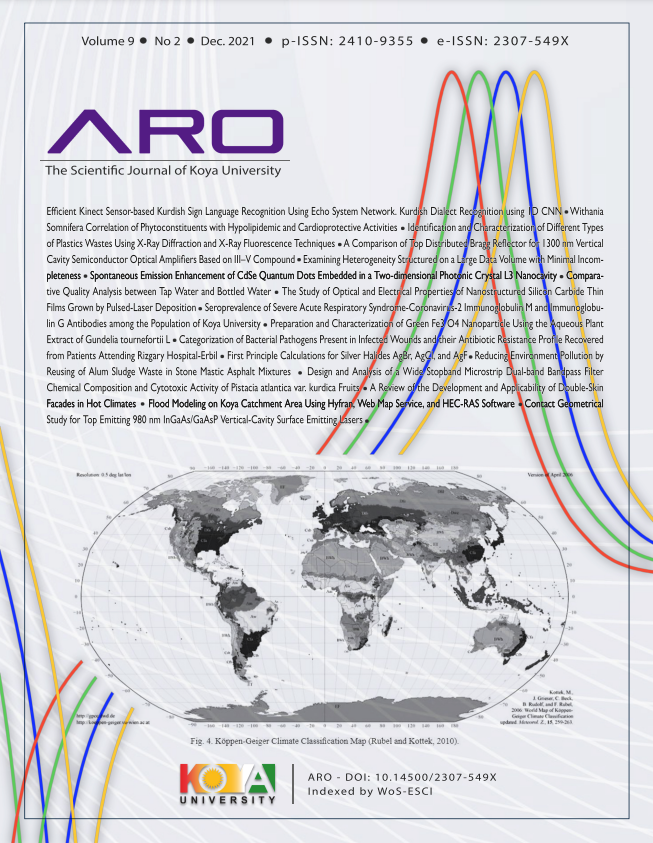A Review of the Development and Applicability of Double-Skin Facades in Hot Climates
DOI:
https://doi.org/10.14500/aro.10859Keywords:
Arid regions, Double-skin Façade, Hot climate, Middle EastAbstract
A double-skin façade (DSF) is a multilayered skin that was initially designed for the cold climate of European countries with noticeable success. Since then, countries in different climates started looking into the possibility of adopting DSF through the use of computer simulations to avoid any unforeseen problems in real life. This study aims to look into the possibility and level of success in using DSF in the Middle East’s hot-arid climate, making it a challenge compared to European countries. The study utilized a quantitative investigative approach in analyzing the results of some studies done in different countries in the Middle East. After looking into the results from different papers, careful considerations have to be made for the building due to its location and microclimate to
determine specific parameters (e.g., combination of transparent and opaque materials, proportion between floor level and screen height, orientation and cavity depth), these would lead to a significant impact on reducing a building’s cooling loads and energy efficiency. It is worth noting that mechanical ventilation (e.g., supplying all return cool air from internal spaces into the DSF cavity or integrating the building’s heating, ventilation, and air-conditioning system with the façade) is necessary for DSF in hot climates to cool and maintain its cavity’s temperature to function properly. However, this increases cooling loads, energy consumption, and running costs of the building which architects have to consider to determine the most efficient and economical solution in material and equipment.
Downloads
References
Alahmed, Z.A., 2013. Double-Skin Façade in Hot-Arid Climates Computer Simulations to Find Optimized Energy and Thermal Performance of Double Skin Facades, MSc Thesis, University of Southern California, Los Angeles.
Azarbayjani, M., 2011. Climatic based consideration of double skin façade system: Natural ventilation performance of a case study with double skinfaçade in Mediterranean climate. In: 13th Conference of International Building Performance Simulation Association, IBPSA France, Chambéry.
Blumenberg, J., Spinnler, M. and Sattelmayer, T., 2006. Double skin façade systems-a comprehensive review on thermal and energetic behavior. In: International Conference on Recent Advances in Heat Transfer, Technische Universität München, Munich.
Boake, T.M., 2014. Hot climate double façades: Avoiding solar gain. In: Facade Tectonics, University of Waterloo, Canada.
Boake, T.M., Harrison, K., Collins, D., Balbaa, T., Chatham, A., Lee, R. and Andre, B., 2001. The Tectonics of the Double Skin: Green Building or Just More
Hi-Tech Hi-Jinx? What are Double Skin Facades and How Do They Work? Casestudies, University of Waterloo, Waterloo.
Cetiner, I. and Ozkan, E., 2005. An approach for the evaluation of energy and cost efficiency of glass facades. Energy and Buildings, 37, pp.673-684.
Ghasemi, N. and Ghasemi, F., 2017. Double-skin façade technology and its aspects in field of aesthetics, environment and energy consumption optimization.
International Journal of Scientific Study, 5, pp.293-307.
Hamza, N. and Underwood, C., 2005. CFD assisted modeling of double skin facades in hot arid areas. In: 9th International Building Performance Simulation Association Conference (IPBSA), Montreal.
Hamza, N., 2008. Double versus single skin facades in hot arid areas. Energy and Buildings, 40, pp.240-248.
Hashemi, N., Fayaz, R. and Sarshar, M., 2010. Thermal behaviour of a ventilated double skin facade in hot arid climate. Energy and Buildings, 42, pp.1823-1832.
Knaack, U., Klein, T., Bilow, M. and Auer, T., 2007. Façades: Principles of Construction. Birkhauser Verlag AG, Berlin.
Kragh, M., 2000. Building Envelopes and Environmental Systems – Permasteelisa R&D and the increasingly required integral design approach. In: Modern Façades for Office Buildings. Delft Technical University, Netherlands.
Lam, J., 2000. Energy analysis of commercial buildings in subtropical climates. Building and Environment, 35, pp.19-26.
Poirazis, H., 2004. Double Skin Façades for Office Buildings, Literature Review, Lund University, Lund.
Radhi, H., Sharples, S. and Fikiry, F., 2013. Will multi-facade sysems reduce cooling energy in fully glazed buildings? A scoping study of UAE buildings. Energy and Buildings, 56, pp.179-188.
Rubel, F. and Kottek, M., 2010. Observed and projected climate shifts 1901-2100 depicted by world maps of the Köppen-Geiger climate classification. Meteorologische Zeitschrift, 19, pp.135-141.
Streicher, W., Heimrath, R., Hengsberger, H., Mach, T., Waldner, R., Flamant, G., Loncour, X., Guarracino, G., Erhorn, H., Erhorn-Kluttig, H., Santamouris, M., Farou, I., Duarte, R., Blomsterberg, A., Sjöberg, L. and Blomquist, C., 2005. BESTFACADE-Best Practice for Double Skin Facades, Report No. WP1.
Wallner, J. and Pottmann, H., 2011. Geometric computing for freeform architecture. Journal of Mathematics in Industry, 1, p.4.
Yagoub, W., Appleton, S. and Stevens, W., 2010. Case study of double skin façade in hot climates. In: Adapting to Change: New Thinking on Comfort, Network for Comfort and Energy Use in Buildings, London.
Yellamraju, V., 2004. Evaluation and Design of Double-Skin Facades for Office Buildings in Hot Climates, MSc Thesis, Texas A&M University, College Station.
Zhou, J. and Chen, Y., 2011. Areview on applying ventilated double-skin facade to buildings in hot-summer and cold-winter zone in China. Renewable and Sustainable Energy Reviews, 15(3), pp.1468-1475.
Downloads
Published
How to Cite
Issue
Section
License
Authors who choose to publish their work with Aro agree to the following terms:
-
Authors retain the copyright to their work and grant the journal the right of first publication. The work is simultaneously licensed under a Creative Commons Attribution License [CC BY-NC-SA 4.0]. This license allows others to share the work with an acknowledgement of the work's authorship and initial publication in this journal.
-
Authors have the freedom to enter into separate agreements for the non-exclusive distribution of the journal's published version of the work. This includes options such as posting it to an institutional repository or publishing it in a book, as long as proper acknowledgement is given to its initial publication in this journal.
-
Authors are encouraged to share and post their work online, including in institutional repositories or on their personal websites, both prior to and during the submission process. This practice can lead to productive exchanges and increase the visibility and citation of the published work.
By agreeing to these terms, authors acknowledge the importance of open access and the benefits it brings to the scholarly community.
Accepted 2021-11-22
Published 2021-12-20
















 ARO Journal is a scientific, peer-reviewed, periodical, and diamond OAJ that has no APC or ASC.
ARO Journal is a scientific, peer-reviewed, periodical, and diamond OAJ that has no APC or ASC.